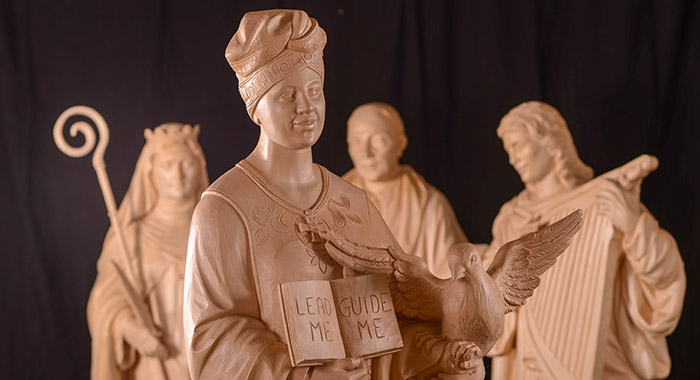Figures of Faith Preside Over Birder Hall
A Franciscan sister on her way to sainthood stands among four artists of faith celebrated in a series of statues commissioned for Birder Hall.
Arguably the least familiar figure of the four, Thea Bowman, F.S.P.A., may yet become the first African-American woman to be canonized. Her religious order is examining evidence of the nun’s sanctity – evidence that could support the cause for her canonization.
Bowman, representing liturgical dance, stands with King David (representing music), Hildegard of Bingen (the visual arts) and C. S. Lewis (literature).
“Least known among the four [statues] may be Sister Thea, a Roman Catholic sister with deep Wisconsin roots,” says Julie Massey ’87 (Mission & Ministry). “She became well-known in Catholic circles as a poet, teacher, singer and a stunning preacher. I actually had the blessing to hear her preach decades ago at the Black Catholic Revival in Chicago, an experience I have not forgotten. She was a respected academic and a woman of profound and active faith – the perfect selection to round out the four figures chosen for this installation.”
An advocate for her people in the church
Bertha Bowman was born in Yazoo City, Miss., to Protestant parents in 1937. She was enthralled by the Franciscan Sisters of Perpetual Adoration, who ran her school, and by the age of nine was asking if she could convert to Catholicism. Bowman entered the St. Rose Convent in La Crosse, Wis., at age 15, where her name in religion became Thea. It was at the Catholic University of America in Washington, D.C., where she received her doctorate in English literature and linguistics, that she found her life’s work both as an African-American and sister of the Catholic faith.
During her travels around the United States, she became an advocate of her people’s heritage, speaking to congregations and singing with a voice described as “God-gilded.”
She worked to introduce celebratory dance and new liturgical music to the church, hoping to provide more ways for African-American Catholics to express their traditions freely. Bowman even backed the establishment of the first African-American Catholic hymnal.
Bowman was a key figure, too, at Viterbo University, where she served as chair of the English department and director of the Hallelujah Singers. She also helped establish the Institute of Black Catholic Studies at Xavier University of New Orleans.
Bowman died in 1990 at the age of 52. Her legacy lives on through the cause for her canonization and the Bowman Foundation, which works to help impoverished African-American children find opportunity through Catholic schools.
Artists of faith take their place in Birder Hall
A statue of Bowman now takes its place among the series commissioned for Birder Hall. They celebrate both its current use as a recital hall and its ecclesiastical origins as the former St. Boniface Church.
Massey, along with the Rev. Jay Fostner, O.Praem., ’84 (Mission & Student Affairs) and the Rev. Jim Neilson, O.Praem., ’88 (Art), worked to choose noteworthy artists of faith who would represent a range of creative expression – music, literature, dance and the visual arts.
“While understanding that four statues could only represent so much,” Massey says, “those of us involved aimed for diverse representations of figures from the Judeo-Christian experience.” The team sought to include women and men from various cultures, traditions and points in history who also made a wide range of contributions to the arts.
The community at St. Norbert Abbey had already been working with German craftsmen to create a number of statues for the abbey dining area. For that project, depicting Norbertine saints and blessed, they had commissioned the Albl family of Oberammergau, Germany, a family of woodcarvers whose expertise dates back to the 16th century.
These 13th-generation woodcarvers accepted the new commission and worked for months to hand-carve the Birder Hall series from solid limewood.
“They are beautiful and elegant, as is that space in its entirety,” Massey says. “I think people will have a sense of appropriate fit with the space, just simply on the sensory level.”
Designers within the St. Norbert community, including Pam Wieseckel ’05 who now works for Wild Blue Technology, and Sherri Baierl (Mission & Student Affairs), joined the project to ensure fit placement of the series.
A glorious tribute
“I think it is glorious how these four figures blur the worlds of intellect, the arts and faith,” Massey says. “That is the message. All three areas have merit, so as an institution we promote their integration. We put forth the idea that the life of the spirit and the expression of the arts have a long, interwoven place together.”
Feb. 3, 2015












